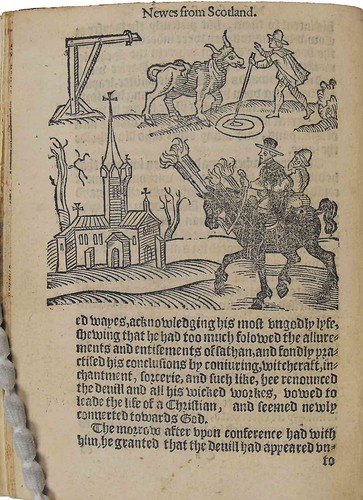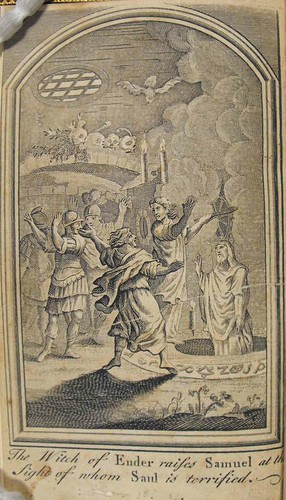Witchcraft and Demonology in: Scotland
Newes from Scotland. Declaring the damnable life of Doctor Flan a notable sorcerer, who was burned at Edenbrough in Ianuarie last. 1591 ...
[London] Printed for William Wright [1591]; quarto (Sp Coll Ferguson Al-a.30, Sp Coll Ferguson Al-a.36)
The earliest tract on Scottish witchcraft. Ferguson knew of only four copies of this edition, two of which were in his own collection. Two other undated editions appeared probably in the same year.
John Flan, a schoolmaster of Saltpans, was the best known of those convicted at the trials of the North Berwick witches in 1590.
James I, King of England, 1566-1625. Daemonologie, in forme of a dialogue, diuided into three bookes.
Edinburgh, Robert Walde-graue, 1597; quarto (Sp Coll Ferguson Ag-d.13)
Written before his accession to the English throne, the Daemonologie probably had its origins in the trials of the North Berwick witches in 1590, which James personally supervised. The work refutes the views of Scot and Weyer and is of importance mainly as having guided public opinion for many years, and of being responsible for at least part of the relentlessness of witch persecutions.
Sinclair, George, d. 1696. Satans invisible world discovered.
Edinburgh, John Reid, 1685; octavo (Sp Coll Ferguson Al-b.92, Sp Coll Ferguson Af-d.14)
There are two copies of this first edition of Sinclair’s work in the Ferguson Collection; only a few other copies are known. This is not surprising for the edition must have been read out of existence. The work was extremely popular; Ferguson knew of ten subsequent editions.
Sinclair was Professor successively of Philosophy and Mathematics at Glasgow University. He was dismissd for nonconformity in 1666, reappointed in 1688, and died in 1696.
Bell, John, 1676-1707. Witch-craft proven, arreign’d, and condemn’d.
Glasgow, Robert Sanders, 1697; duodecimo (Sp Coll Ferguson Al-c.25, Sp Coll Ferguson Al-c.26)
The author was born at Glasgow in 1676, subsequently became minister of Gladsmuir, and died in 1707. Of this short tract, badly printed on poor paper and published anonymously, Ferguson says: "One of the very rarest of the Scottish witchcraft tracts ... This miserable little pamphlet enables one to realise how the clergy had argued themselves into being such ardent witchhunters". - Bibliographcal notes on the witchcraft literature of Scotland.
Cullen, Francis Grant, Lord, 1658-1726. A true narrative of the sufferings and relief of a young girle; strangely molested, by evil spirits ... in the West: collected from authentick testimonies, thereanent.
Edinburgh, James Watson, 1698; octavo (Sp Coll Ferguson Al-b.77, Sp Coll Ferguson Al-b.87)
An account of Christian Shaw and the Renfrewshire witches. The particulars were collected by John MacGilchrist, town-clerk of Glasgow, and written out by Francis Grant, advocate, later Lord Cullen.
A true and full relation of the witches at Pittenweem.
Edinburgh, John Reid Junior, 1704; duodecimo (Sp Coll Mu56-h.29)
In 1704 accusations made by a sixteen-year-old youth Patrick Morton (Peter Morton in some accounts) brought several persons to trial on charges of practising witchcraft at Pittenweem, a coastal town in the east of Scotland. Though none of the accused was condemned to death by the court, a mob, enraged by the escape of one of the prisoners, Janet Corphat (or Cornfoot), pursued her and pressed her to death.
An answer of a letter from a gentleman in Fife, to a nobleman, containing a brief account of the barbarous and illegal treatment, these poor women accused of witchcraft, met with from the baillies of Pittenweem and others.
Edinburgh? 1705; quarto (Sp Coll Ferguson Al-a.38)
A condemnation of the barbarities and injustices committed against those accused of witchcraft at Pittenweem.
The history of witches, ghosts, and Highland seers: containing many wonderful well-attested relations of supernatural appearances ...
Berwick, for R. Taylor, [1803]; duodecimo (Sp Coll Ferguson Al-b.40)
Contains many Scottish examples of witchcraft, second sight, dreams, and apparitions. Some of the Scottish episodes come from Sinclair. The frontispiece shows the raising of Samuel by the witch of Endor.
Scott, Walter, Sir, 1771-1832. Letters on demonology and witchcraft, addressed to J.G. Lockhart, Esq.
London, John Murray, 1830. (Sp Coll Ferguson Af-b.67, Sp Coll Ferguson Al-b.67)
This work is the culmination of Scott’s interest in witchcraft and demonology. Letter IX is devoted specifically to witchcraft in Scotland. This is a copy of the first edition.
The frontispiece, drawn by J. Skene and engraved by W.H. Lizars, is of the Bow, Edinburgh, showing the house of Major Thomas Weir, who, together with his sister, Jane, was executed for practising witchcraft in 1670.
Back to see books on Witchcraft and Demonology in England
Forward to see books on Witchcraft and Demonology in North America


















